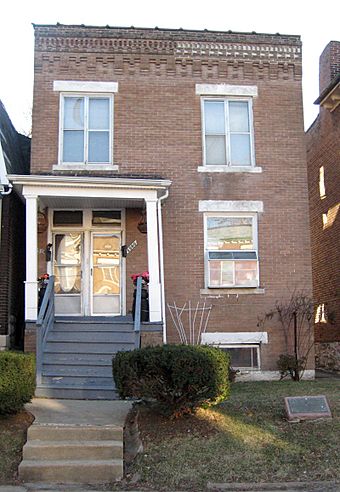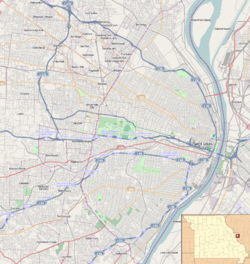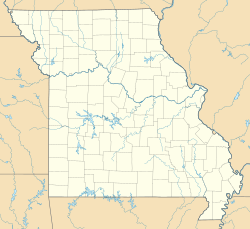Shelley House (St. Louis, Missouri) facts for kids
|
Shelley House
|
|
 |
|
| Location | 4600 Labadie Ave., St. Louis, Missouri |
|---|---|
| Built | 1906 |
| Architect | H.C. Miller |
| NRHP reference No. | 88000437 |
Quick facts for kids Significant dates |
|
| Added to NRHP | April 18, 1988 |
| Designated NHL | December 14, 1990 |
The Shelley House is a special old house located at 4600 Labadie Avenue in St. Louis, Missouri. It was built in 1906. This house is famous because it was at the center of a very important court case in 1948 called Shelley v. Kraemer. In this case, the highest court in the United States, the Supreme Court, decided that rules preventing people of certain races from buying homes were against the U.S. Constitution. Because of its importance, the Shelley House was named a National Historic Landmark on December 14, 1990.
Contents
What the Shelley House Looks Like
The Shelley House is a two-story brick building. It's a type of home called a rowhouse, which means it's one of several houses built right next to each other in a row. It's also a duplex, meaning it has two separate apartments, one upstairs and one downstairs. You can find many houses like it in the Fairground district of St. Louis.
The house still looks much like it did when it was built. It has two separate doors on the front porch, one for the upstairs apartment and one for the downstairs apartment. The front porch has brick pillars and a wooden roof. Both apartments have a four-room layout with a hallway on the side. The rooms at the front of the house have a fireplace. There's also an addition at the back of the house with an extra bedroom on each level.
The Story of the Shelley House
A Family's Journey
The J. D. Shelley family moved to St. Louis in 1930 from Starkville, Mississippi. They were looking for a safer place to live, away from racial violence. After renting homes for a while, the Shelleys wanted to buy a house of their own. In 1945, they decided to buy the house at 4600 Labadie.
The Restrictive Covenant
What the Shelleys didn't know was that the house had a special rule from 1911. This rule, called a "restrictive covenant," said that the house could not be sold to anyone of "Negro or Mongolian race" for fifty years. These types of rules were common at the time and were used to keep neighborhoods separated by race.
Taking the Case to Court
The Louis D. Kraemer family, who owned other property on the street, sued the Shelleys. They wanted to stop the Shelleys from owning the house because of the old rule. At first, a local court sided with the Shelleys. But then, the Missouri Supreme Court changed that decision in 1946, saying the restrictive covenant was valid.
The Shelleys didn't give up. They appealed their case to the highest court in the country, the United States Supreme Court, in 1947.
A Landmark Decision
Something very important happened during this case. For the first time in a civil rights case, the U.S. government's legal office, the Office of the Solicitor General, sent a special letter to the Supreme Court. This letter, called an amicus curiae (which means "friend of the court"), supported the Shelleys.
On May 3, 1948, the Supreme Court made a huge decision. They ruled that these racially restrictive covenants could not be enforced by courts. The Court said that if a state court enforced such a rule, it would go against the Fourteenth Amendment to the United States Constitution. This amendment guarantees equal protection under the law for all citizens. This decision was a big step forward for civil rights in the United States, making it harder to use race to stop people from buying homes.




